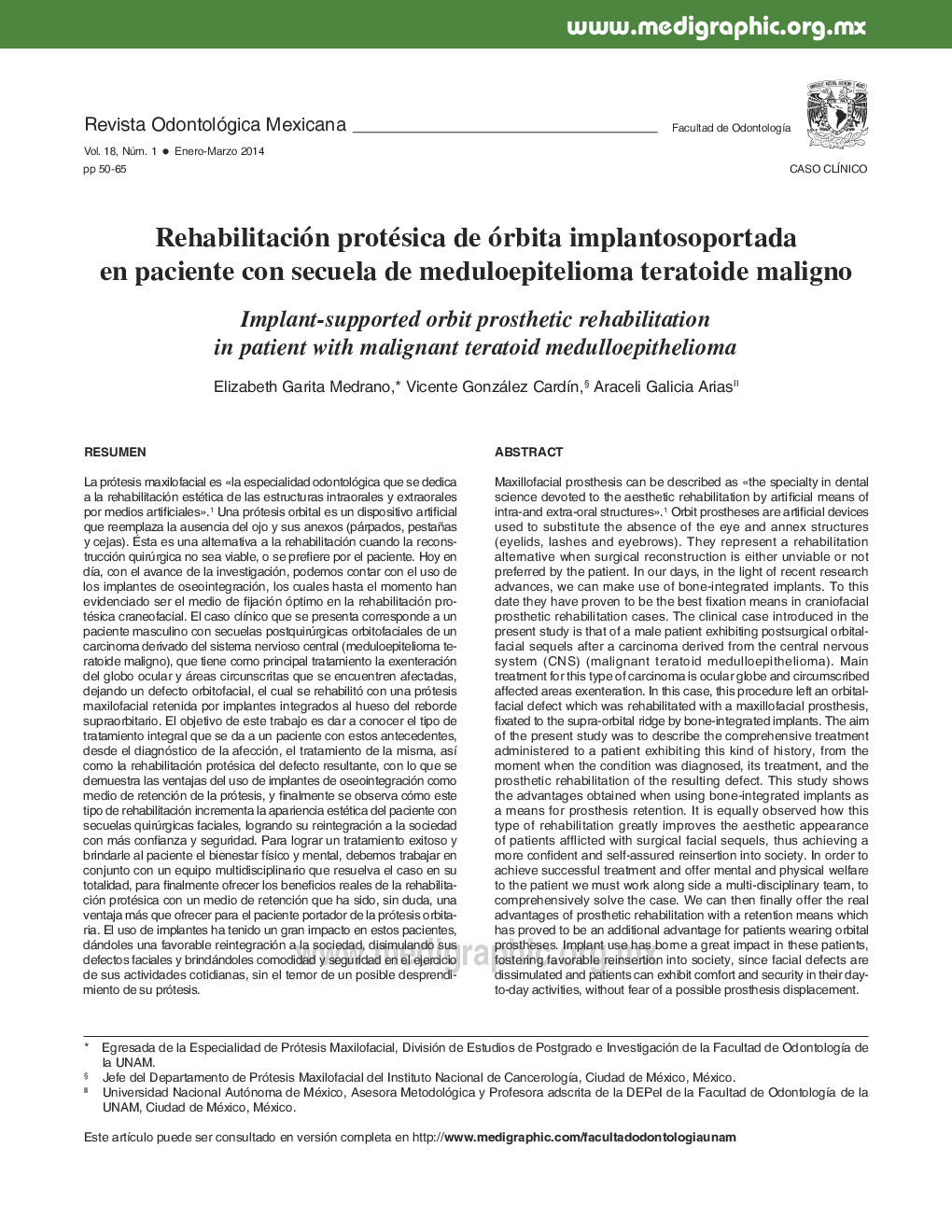| کد مقاله | کد نشریه | سال انتشار | مقاله انگلیسی | نسخه تمام متن |
|---|---|---|---|---|
| 3173177 | 1199999 | 2014 | 16 صفحه PDF | دانلود رایگان |

ResumenLa prótesis maxilofacial es «la especialidad odontológica que se dedica a la rehabilitación estética de las estructuras intraorales y extraorales por medios artificiales».1 Una prótesis orbital es un dispositivo artificial que reemplaza la ausencia del ojo y sus anexos (párpados, pestañas y cejas). Ésta es una alternativa a la rehabilitación cuando la reconstrucción quirúrgica no sea viable, o se prefiere por el paciente. Hoy en día, con el avance de la investigación, podemos contar con el uso de los implantes de oseointegración, los cuales hasta el momento han evidenciado ser el medio de fijación óptimo en la rehabilitación protésica craneofacial. El caso clínico que se presenta corresponde a un paciente masculino con secuelas postquirúrgicas orbitofaciales de un carcinoma derivado del sistema nervioso central (meduloepitelioma teratoide maligno), que tiene como principal tratamiento la exenteración del globo ocular y áreas circunscritas que se encuentren afectadas, dejando un defecto orbitofacial, el cual se rehabilitó con una prótesis maxilofacial retenida por implantes integrados al hueso del reborde supraorbitario. El objetivo de este trabajo es dar a conocer el tipo de tratamiento integral que se da a un paciente con estos antecedentes, desde el diagnóstico de la afección, el tratamiento de la misma, así como la rehabilitación protésica del defecto resultante, con lo que se demuestra las ventajas del uso de implantes de oseointegración como medio de retención de la prótesis, y finalmente se observa cómo este tipo de rehabilitación incrementa la apariencia estética del paciente con secuelas quirúrgicas faciales, logrando su reintegración a la sociedad con más confianza y seguridad. Para lograr un tratamiento exitoso y brindarle al paciente el bienestar físico y mental, debemos trabajar en conjunto con un equipo multidisciplinario que resuelva el caso en su totalidad, para finalmente ofrecer los beneficios reales de la rehabilitación protésica con un medio de retención que ha sido, sin duda, una ventaja más que ofrecer para el paciente portador de la prótesis orbitaria. El uso de implantes ha tenido un gran impacto en estos pacientes, dándoles una favorable reintegración a la sociedad, disimulando sus defectos faciales y brindándoles comodidad y seguridad en el ejercicio de sus actividades cotidianas, sin el temor de un posible desprendimiento de su prótesis.
Maxillofacial prosthesis can be described as «the specialty in dental science devoted to the aesthetic rehabilitation by artificial means of intra-and extra-oral structures».1 Orbit prostheses are artificial devices used to substitute the absence of the eye and annex structures (eyelids, lashes and eyebrows). They represent a rehabilitation alternative when surgical reconstruction is either unviable or not preferred by the patient. In our days, in the light of recent research advances, we can make use of bone-integrated implants. To this date they have proven to be the best fixation means in craniofacial prosthetic rehabilitation cases. The clinical case introduced in the present study is that of a male patient exhibiting postsurgical orbitalfacial sequels after a carcinoma derived from the central nervous system (CNS) (malignant teratoid medulloepithelioma). Main treatment for this type of carcinoma is ocular globe and circumscribed affected areas exenteration. In this case, this procedure left an orbitalfacial defect which was rehabilitated with a maxillofacial prosthesis, fixated to the supra-orbital ridge by bone-integrated implants. The aim of the present study was to describe the comprehensive treatment administered to a patient exhibiting this kind of history, from the moment when the condition was diagnosed, its treatment, and the prosthetic rehabilitation of the resulting defect. This study shows the advantages obtained when using bone-integrated implants as a means for prosthesis retention. It is equally observed how this type of rehabilitation greatly improves the aesthetic appearance of patients afflicted with surgical facial sequels, thus achieving a more confident and self-assured reinsertion into society. In order to achieve successful treatment and offer mental and physical welfare to the patient we must work along side a multi-disciplinary team, to comprehensively solve the case. We can then finally offer the real advantages of prosthetic rehabilitation with a retention means which has proved to be an additional advantage for patients wearing orbital prostheses. Implant use has borne a great impact in these patients, fostering favorable reinsertion into society, since facial defects are dissimulated and patients can exhibit comfort and security in their day-to-day activities, without fear of a possible prosthesis displacement.
Journal: Revista Odontológica Mexicana - Volume 18, Issue 1, January–March 2014, Pages 50–65